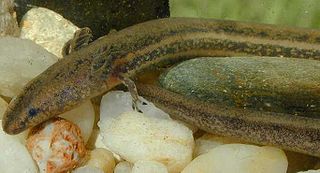
Sirenidae, the sirens, are a family of neotenic aquatic salamanders. Family members have very small fore limbs and lack hind limbs altogether. In one species, the skeleton in their fore limbs is made of only cartilage. In contrast to most other salamanders, they have external gills bunched together on the neck in both larval and adult states. Sirens are found only in the Southeastern United States and northern Mexico.

The greater siren is an amphibian and one of the three members of the genus Siren. The largest of the sirens and one of the largest amphibians in North America, the greater siren resides in the coastal plains of the southeastern United States.

Siren is a genus of aquatic salamanders of the family Sirenidae. The genus consists of five living species, along with one extinct species from the Eocene Epoch and three from the Miocene.

The southern dwarf siren, is a perennibranch salamander lacking hind legs. Found exclusively in Florida, it is one of two currently recognized species of dwarf sirens. Two subspecies are currently recognized; P. a. axanthus, the narrow-striped dwarf siren, and P. a. belli, the Everglades dwarf siren.

The northern dwarf siren is a perennibranch salamander lacking hind legs. Found in the Southeastern United States, it one of two currently recognized species of dwarf sirens. Three subspecies are currently recognized; P. s. striatus, the broad-striped dwarf siren, P. s. lustricolus, the Gulf Hammock dwarf siren, and P. s. spheniscus, the slender dwarf siren.

The striated bulbul is a species of songbird in the bulbul family, Pycnonotidae. It is the only species placed in the genus Alcurus .
Wilfred T. Neill (1922–2001) was an American herpetologist and author. His name survives in the scientific names of the central Florida crowned snake, Tantilla relicta neilli, and a Central American snail-eating snake, Sibon sanniolus neilli.

Pristiophorus is a genus of sawsharks found in the Pacific, Atlantic and Indian oceans. Members of this genus differ from the Sixgill Sawshark (Pliotrema warreni) in having five gill slits. Their rostral sawteeth lack prominent transverse ridges on the basal ledges, and the large teeth are not posteriorly serrated.

Cynoscion is a genus of marine ray-finned fishes belonging to the family, Sciaenidae, the drums and croakers. These fishes are found off the coasts of North and South America in the western Atlantic and eastern Pacific Oceans. Many fishes in this genus have been given the common name weakfish.









